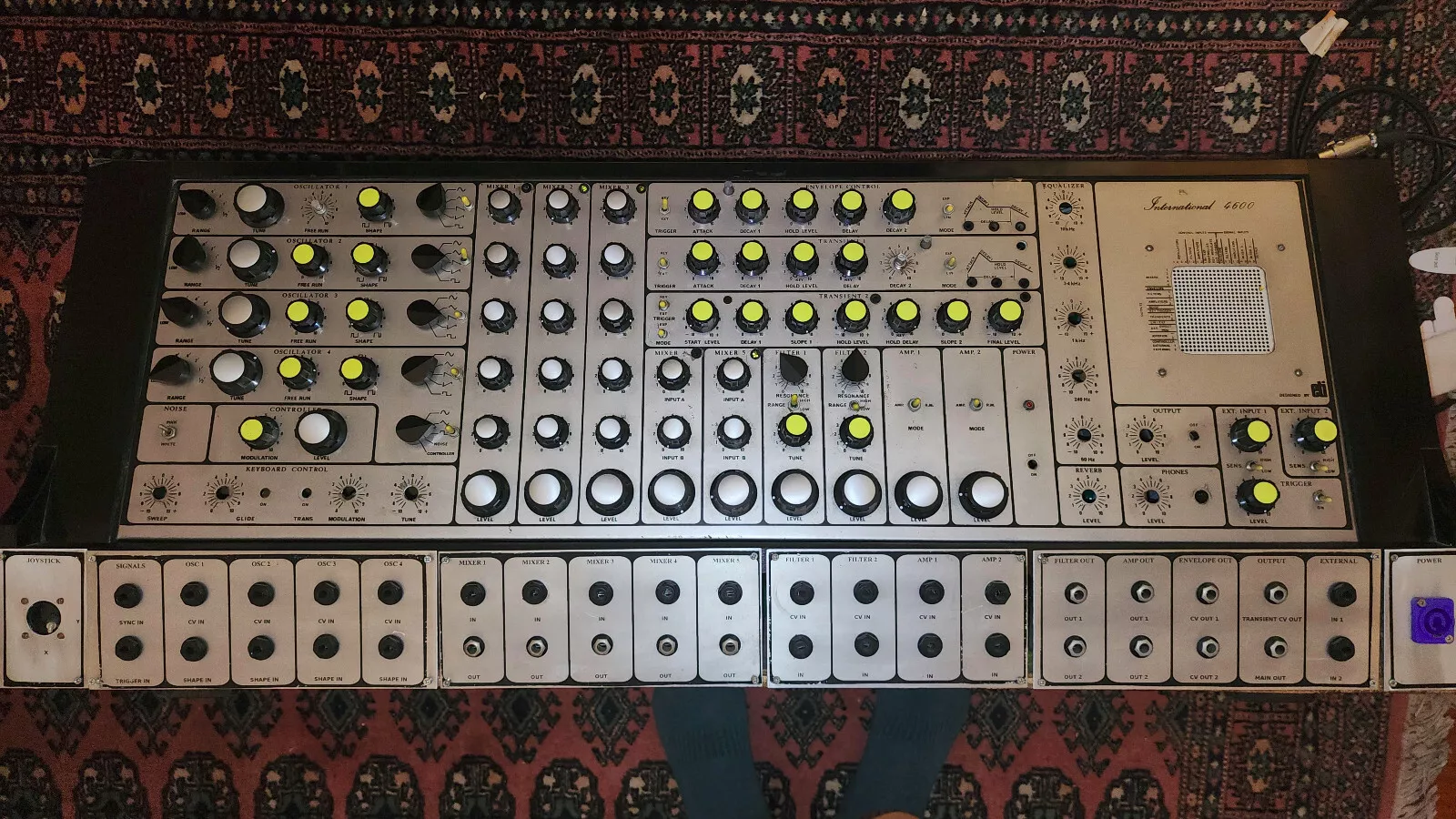“This is a large semi-modular synthesizer, designed in Australia and released as a kit by Electronics Today International magazine in 1973. The large aluminium panel pivots forward for maintenance. Its 22×22 matrix switchboard, joystick, complex modulation and feature set is reminsicent of a larger EMS VCS3, a comparison enhanced by the use of genuine Cliff “little Dalek” knobs.
The main modules in the 4600 design were repackaged for the (smaller) ETI 3600 and the lightly larger Maplin 5600 kit synthesizers. Its notable features are volts-per-herz VCOS (rather than volts-per-Octave linear VCOs), complex Transient Generators that are like simple three stage sequencers, and a different-sounding VCF.
This is a rare, powerful and unique synthesizer that needs some TLC from a competent builder to unlock its potential.
STORY
In the early 80s before it had been completely built, it suffered damage (the plaster ceiling collapsed on it, because of a shoddy repair job after the previous tenants, a punk gang, had a “demolition party” that destroyed all internal walls). The keyboard was destroyed and there seemed little reason to replace it (the first 4600 keyboard circuitry was problematic and had been replaced by a design from the Fairlight team.) There was some scratches to the case and a lot of dust, though the pots did not seem scratchy.
Periodically I would bring it out of storage and work on it, with various planned enhancements:
I cut the front off and added panels to allow patch cords to connect with other modules, as well as using the matrix.
I replaced the internal wiring with shielded cabling: this was very successful in removing beehive noise but its .
I insulated some pots against earthing to the chassis that caused hum.
I put in a Neutrix Powercon replacement for the (dangerous?) use of an XLR power connector.
But I lost the interest to complete it as I started to design and build my own modules, and as my build skills improved.
Due to a house move, it is time for it to find some museum, engineer or technically-capable hobbyist to complete it.
MODULE STATUS
This was the status of the modules five years ago.
Power Supply – Tested and working.
Oscillator 1 – All Range settings, Tune, Free run, Shape and All waveforms tested and working.
Oscillator 2 – All Range settings, Tune, Free run, Shape and All waveforms tested and working.
Oscillator 3 – All Range settings, Tune, Free run, Shape and All waveforms tested and working.
Oscillator 4 – All Range settings, Tune, Free run, Shape and All waveforms tested and working.
Oscillator 4, Second output – All waveforms, including noise selection and Controller tested and working.
Noise generator – Pink and white tested and working.
Controller – tested and working.
Mixer 1 – Tested and working.
Mixer 2 – Tested and working.
Mixer 3 – Tested and working.
Mixer 4 – Tested and working.
Mixer 5 – Tested and working.
Main Output – Tested and working
Headphone Output – Tested and working
Keyboard Control – Sweep, Glide, Transient, Modulation and Tune omitted
Keyboard – Omitted
Filter 1 – Built but not tested.
Filter 2 – Built but not tested
Joystick – Built but not tested
External Inputs 1 and 2 – Built but not tested
Amplifiers 1 and 2 – Built but not tested
Envelope control – Built but not tested
Transient 1 – Built but not tested
Transient 2 – Built but not tested
Equalizer – Not built: requires handwound inductors, or could be replaced by other design.
Reverb – Built but not tested (to be confirmed)
Box: black laminate and sturdy plywood, seen better days. Panel inclines back. OK for transport and installed use, but not not suitable for the road.
ENHANCEMENTS
Envelope and Transient Generators: LEDs drilled to allow blinkenlicht for sequence position of Transients. Added pots for Peak or velocity.
Internal wiring to matrix mixer uses ugly shielded cable, which utterly removes otherwise bad beehive noise.
Added bottom row of panels to break out the modules’ inputs and outputs: not connected.
Joystick on bottom row: not connected
Neutrix Powercon connector on bottom row: not connected.
VCO and Mixer: high quality op-amps generally used instead of LM301s gives much crisper sound
Uses genuine Cliff knobs and teardrop pointers
Power supply: capacitors re-furbished 10 years ago. Side PC board added to allow LED and protection.
EXTRAS
Reverb tank provided
Extra hard-to-source LM4066 switches: some extra will be provided for future spares
Some extra Cliff knobs will be provided
Powercon and XLR cable provided (Australian plugs)
MISSING
If I track down the build manual, I will provide that. It is available on the WWW anyway.
If I track down extra matrix pins, I will provide them.
The keyboard PCB (lower left) is not available.
SIZE
Weight: approx 20kg
Size: 105 x 45 x 30 cm”
Click here to visit listing on eBay
